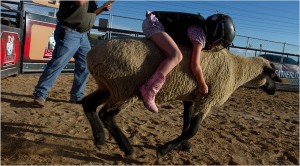General George Patton often declared in his speeches to troops during World War II, “When you were kids, you all admired the champion marble shooter, the fastest runner, the big league ball players, the toughest boxers. Americans love a winner and will not tolerate a loser. Americans play to win all the time.” Now, if you like to ride sheep, aspire to be a bull rider, and are at least three-years-old, I have a new sport for you to play to win: Mutton busting. This week The New York Times ran an article on the kids’ mutton busting circuit in Colorado. Kids, aged three to six, compete to see who can stay on the back of a lamb for the longest amount of time. As with so many other kids’ activities that used to take place without any adult supervision, mutton busting has, “begun to move from horseplay, and the occasional rodeo halftime show, to wider, sometimes suburban, audiences and competitors, toward becoming a codified sport with its own gear and championships.”
This is what mutton busting looks like in action:
(I can’t help but comment on this little girl’s fabulous pink cowboy boots. She clearly knows how to blend a competitive streak with a flair of femininity.)
In contemporary American society everything does seem to be competitive. Organized, tournament-like competitions are held for the seemingly mundane, the inane, and the arcane. We have competitive eating contests, beauty pageants, bodybuilding competitions, spelling bees, video game tournaments, and the list goes on—not to mention any competitive sporting event you can imagine, from soccer on inline skates to childhood games like dodgeball. Unlike the rest of the world we have more games than practices when it comes to athletic events because Americans tend to place a higher value on competitions than on practices. And all these competitive trends are magnified in childhood.
Why? In my work I draw a connection between the way college admissions works in this country (it’s not purely based on numerical assessments like test scores and GPA—taking into account activities and leadership as well). This system rewards what I call “competitive kid capital,” which kid acquire through participation in competitive afterschool activities. I also argue that the development of formal, organized for-profit competitions, run by adults who make their living off of kids and competition, has helped solidify this system.
In short, it doesn’t surprise me that there is now a circuit for mutton busting. What will they think of next? And, what do you think about this trend?
